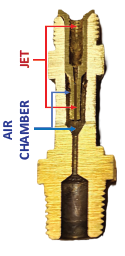A fuel nozzle isn’t as simple as it first appears. Fuel from the fuel system is introduced into the top of the nozzle, and flows through the carefully-sized metered orifice in the jet. At the bottom of the jet, that fuel is mixed with air in an air chamber, and the atomized air/fuel mixture is then sprayed out the bottom of the nozzle assembly. Inside the air chamber is where various debris can hide and then clog up the nozzle when you least expect it.
The pictures in this discussion show nozzles from a normally aspirated Continental, such as an IO-520 or IO-470, but all nozzles work similarly.

Here’s a picture of a fuel nozzle that’s been sawed in half.
In this picture, the fuel flows in from the top, and through the jet. The diagrams below show the relative sizes of the holes in the nozzle.
The fuel flows out the bottom of the jet, and mixes with air that flows in from the outside into the air chamber surrounding the jet. There’s a set of holes through which the air flows (these are visible in the next picture), and the air and fuel mix together in the larger section of the air chamber at the bottom of the jet.
There’s a screen and a shroud around the outside, which are also visible in the next picture.
Generally, the nozzle isn’t disassembled at cleaning time. The screen and shroud can be removed (they’re pressed on), but removing the jet damages it. It’s important to not damage the metered orifice, because it’s very carefully calibrated in order to balance the fuel flows. But we still want to clean any and all debris from the nozzle, even without disassembling it.

Here is a view of the injector body with the screen and shroud removed. You can’t remove the jet without damaging it, so we aren’t going to show that.
Note the small holes just below where the shroud is mounted. Air flows into the nozzle via those holes, and into the air chamber.
The screen is very fine – only air is meant to go through it, and it effectively keeps out any debris.
But – as we’ll see – it also helps to keep debris in!
